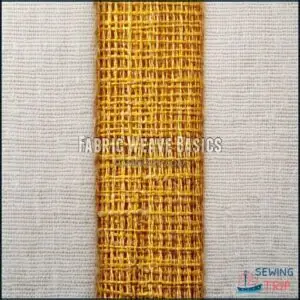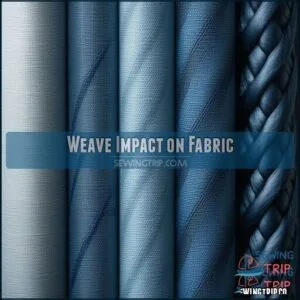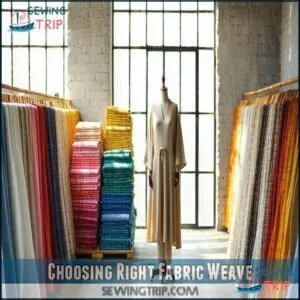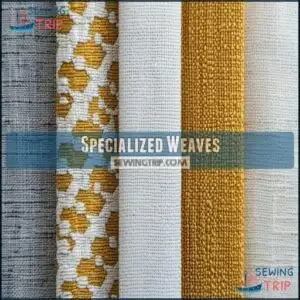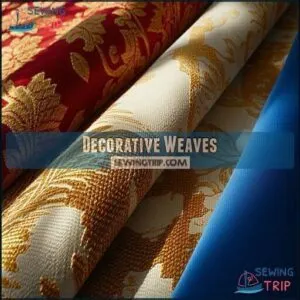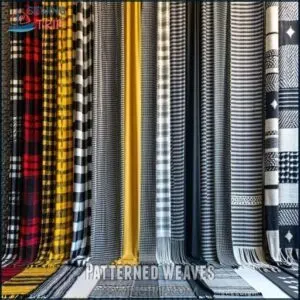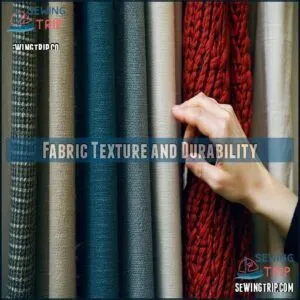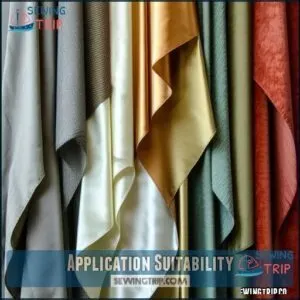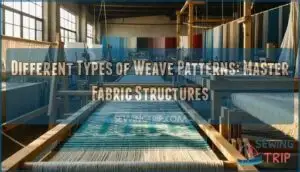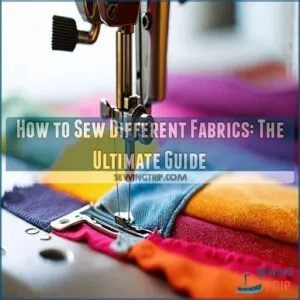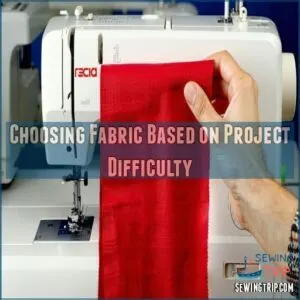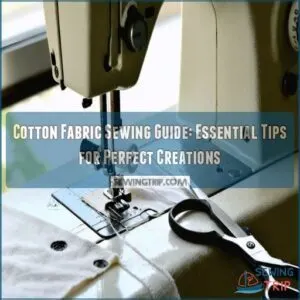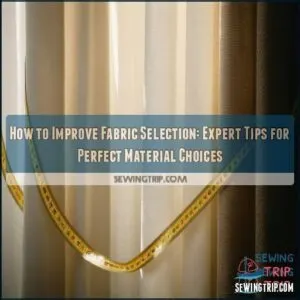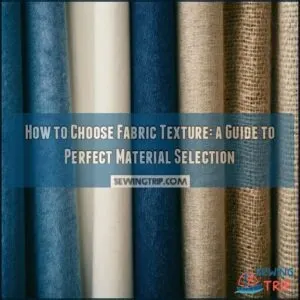This site is supported by our readers. We may earn a commission, at no cost to you, if you purchase through links.
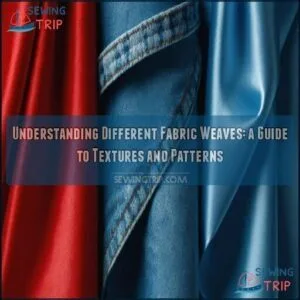
The plain weave is your no-fuss option, offering simplicity and balance—think cotton shirts or bed linens.
Twill weave, with its diagonal lines, brings durability and a soft drape; it’s the secret behind your comfy jeans.
Satin weave steals the show with its smooth texture and luxurious sheen, perfect for formal attire.
Weaves affect breathability, drape, and strength, so picking the right one depends on your needs.
From lightweight to heavy-duty, each weave tells its own story—ready to uncover what makes them tick? Let’s thread this needle to explore the importance of durability and style.
Table Of Contents
Key Takeaways
- You’ll find plain weaves are simple, durable, and perfect for breathable everyday fabrics like cotton shirts and bed linens.
- Twill weaves are strong and flexible, with diagonal lines that make them ideal for heavy-duty items like denim and workwear.
- Satin weaves give smooth finishes and a luxurious sheen, making them great for elegant clothing and decor with a soft, glossy style.
- Choosing the right weave depends on its purpose—plain for light and casual, twill for durability, and satin for elegance and texture.
Fabric Weave Basics
When you think about fabric, its weave is like the blueprint that shapes its texture, strength, and appearance.
Understanding the basics—plain, twill, and satin—helps you see how threads work together to create everything from sturdy denim to silky sheets.
Plain Weave Characteristics
Plain weave is the simplest and most common of all fabric weave types.
Plain weave, the ultimate classic, combines simplicity and versatility, making it the foundation of countless everyday fabrics.
Its crisscross pattern, like a checkerboard, offers exceptional Plain Weave Strength and Weave Durability.
Known for its versatility, it’s used in countless Weave Applications, from T-shirts to bedding.
With great Weave Breathability and Plain Weave Variations, it balances fabric texture and fabric properties effortlessly, making it a timeless choice.
Twill Weave Features
Unlike plain weaves, twill weave stands out with its diagonal ribs, giving fabrics a distinct, slanted look.
This weave structure alternates threads to create durable, flexible fabric properties.
Common in denim applications, twill identification is easy thanks to its sturdy weave patterns.
It’s a favorite for performance fabrics, offering strength and resilience in various weave variations and fabric weave types.
Twill’s versatility stems from its ability to be produced using various fiber types.
Satin Weave Properties
Satin weave stands out with its smooth, glossy finish, created by floating yarns over multiple threads.
Smooth and glossy, satin weave exudes luxury with floating yarns creating a soft, luminous finish perfect for elegance.
This weave structure enhances fabric luster and weave softness, making it feel luxurious.
High filament count adds to satin durability, though it’s prone to snags.
Perfect for elegant apparel, satin weave patterns balance beauty and practicality, proving fabric weaves can be both functional and stunning.
Weave Impact on Fabric
The way fabric threads are woven together directly impacts its breathability, drape, softness, and durability. By understanding weave structures, you can choose the right material for comfort, style, and function.
Breathability Factors
Fabric breathability depends on how air moves through weave patterns. Looser weaves and lighter yarn density help fabrics feel cooler, while tighter ones trap heat.
For better air permeability and moisture wicking, consider these factors:
- Weave looseness: Looser patterns like cotton breathe well.
- Fiber type: Natural fibers excel.
- Weave density: Tighter weaves insulate.
- Moisture wicking: Helps sweat evaporate.
- Air permeability: Enhances comfort.
Drape and Structure
The way fabric drapes depends heavily on its weave structure.
Looser fabric weaves, like chiffon, flow gracefully, while tighter ones, such as satin, cling fluidly to shapes.
Structural integrity and textile rigidity also play a role—heavier fabric weight supports form creation, while lighter options feel airy.
Weave stability guarantees consistent fabric structure, perfect for custom or flowing designs.
Considering the fabric’s hand feel is also important for the intended garment, as it affects the overall fabric drapes and textile rigidity.
Softness and Smoothness
The way fabric feels against your skin depends on yarn fineness, weave tightness, and fiber type.
Satin weave, with its floating yarns, enhances fabric smoothness, while plain weave offers a balanced texture.
Surface treatments can also boost sensory perception, making fabrics softer.
- Satin weave: silky and glossy
- Plain weave: durable but less soft
- Fiber type: natural feels softer
- Surface treatments: improve texture
Durability and Strength
In terms of fabric durability, weave tightness and yarn strength play starring roles.
Tight weaves like twill distribute stress evenly, boosting tear resistance and abrasion resistance.
Fiber composition also matters—stronger fibers enhance fabric strength.
A sturdy weave structure, like plain or twill, makes textiles hold up under pressure, making them perfect for hardworking garments like jeans or jackets.
Shine and Lustre
The shine of fabric weaves depends on light reflection, yarn properties, and weave tightness.
A satin weave, for instance, creates high fabric luster with its smooth surface and floating yarns. Sateen weave offers similar fabric shine but with a softer touch.
Finishing techniques and surface treatments enhance these effects, making fabrics like silk or satin perfect for luxurious looks.
Choosing Right Fabric Weave
When choosing the right fabric weave, you’ll want to think about how it matches the purpose of your project, whether it’s breathable cotton for summer wear or durable twill for heavy use.
Each weave offers unique qualities like texture, strength, and drape, so understanding these can help you pick the perfect fit.
Apparel Fabric Selection
Choosing the right weave for apparel depends on functionality and comfort.
Consider these factors:
- Seasonal Fabrics: Light weaves like cotton for summer, heavier twill for winter.
- Fashion Trends: Satin adds elegance, while plain weaves suit casual looks.
- Comfort Factors: Breathable fabrics like basket weaves keep you cool.
- Cost Analysis: Durable weaves, like twill, save money over time.
Understanding the nuances of different fabric textures can further refine your selection.
Home Decor Fabric Choice
Ever wonder why fabric weaves matter in home decor? Weave durability guarantees your couch survives popcorn spills, while texture importance adds coziness.
Opt for tight weave patterns for better color retention and cleaning ease. Consider cost analysis when choosing intricate textile construction or fabric design.
From curtains to rugs, fabric weaves shape home textiles’ style and practicality. Choosing the right fabric also means considering light filtration properties for curtains, which affects the overall practicality.
Fabric Weave Types
In the context of fabric weave types, understanding the structure can help you pick the right material for your needs.
From basic weaves to intricate patterns, each style offers unique textures, durability, and visual appeal.
Specialized Weaves
Specialized weaves, like jacquard weave and crepe weave, bring unique textures and designs to fabrics.
Leno applications offer stability with twisted threads, while Bedford variations create ribbed patterns.
Pile durability guarantees soft, long-lasting materials, and lappet weave adds surface designs.
Tapestry weave shines with intricate artistry, while double cloth weave layers fabrics for added versatility in fashion and decor.
Many seek fabrics using jacquard for their detailed patterns.
Decorative Weaves
Decorative weaves add flair and functionality to fabrics.
Each type offers unique aesthetics:
- Jacquard weave: Known for its complexity, it creates intricate patterns like brocade and damask.
- Pile textures: Velvet and brocatelle feature soft, raised surfaces.
- Leno stability: Twisted warp threads guarantee durability and an airy look.
These weaves combine artistry and practicality, perfect for elegant interiors or standout apparel.
Dobby weaves are known for geometric motifs.
Patterned Weaves
From artistic tapestry art to stylish striped weaves, patterned fabrics bring personality to your projects.
Double cloth upgrades layering, while dobby patterns add geometric charm.
Checkered designs, like Glen checks, bring timeless appeal.
For intricate detailing, jacquard and lappet weaves are perfect.
| Pattern Type | Key Feature | Common Use | Distinct Quality |
|---|---|---|---|
| Striped Weaves | Color alternation | Shirts, ties | Sleek and bold lines |
| Checkered Designs | Square patterns | Tablecloths, blouses | Classic, versatile style |
| Double Cloth | Double layering | Coats, upholstery | Durable and structured |
| Tapestry Weave | Artistic detailing | Rugs, hangings | Intricate, vivid designs |
Weave Selection Considerations
When choosing a fabric weave, think about how texture, durability, and appearance match your needs.
Whether you’re picking material for clothes or home decor, a weave’s structure plays a big role in how the fabric looks and performs.
Fabric Texture and Durability
Fabric weaves impact texture and durability more than you’d think.
Weave tightness and yarn quality decide how soft or sturdy a fabric feels. A tighter structure boosts abrasion resistance and tear strength, while fiber composition influences overall resilience.
Thoughtful weaving techniques produce materials that stand up to wear yet feel comfortable, balancing fabric texture and fabric durability perfectly for everyday use.
Weave and Appearance
The weave structure directly shapes a fabric’s appearance, affecting how light plays on its surface and its overall visual texture.
Plain weave offers simplicity, while twill weave adds depth with diagonal lines, and satin weave gleams with surface sheen.
Here’s how different weaves impact the way fabric looks:
- Pattern complexity: Simpler or intricate designs.
- Surface sheen: Satin weaves shine.
- Color interaction: Enhances fabric vibrancy.
- Fabric hand: Influences its feel.
- Visual texture: Subtle or bold patterns.
Application Suitability
Choosing the right weave depends on fabric performance and functionality.
For apparel applications, plain weaves suit casual wear, while twill weaves offer durability for workwear.
Home decor benefits from decorative weaves like velvet for elegance.
Technical textiles prioritize strength and flexibility, while medical fabrics need breathability.
Woven fabrics are often selected for their inherent strength properties, and fabric selection balances characteristics, ensuring suitability for industrial uses, fashion, or everyday needs.
Frequently Asked Questions (FAQs)
How to tell what kind of weave a fabric is?
Think of weave types as fabric’s fingerprints.
Hold it to light; plain weaves show a grid, twill shows diagonal lines, and satin gleams smoothly.
Feel it—tightness, texture, and shine are key clues.
What are the 5 types of weave patterns used in textiles?
You’ll find five main textile weave patterns: plain (simple and durable), twill (diagonal and sturdy), satin (smooth and glossy), basket (textured and decorative), and rib (raised lines for added texture and strength).
How many fabric weaves are there?
Ever wonder how many fabric weaves exist?
There are countless types, from basics like plain, twill, and satin to specialized ones like herringbone and jacquard.
Each weave creates unique textures, patterns, and uses!
What is the strongest fabric weave?
The plain weave is the strongest.
Its tightly crisscrossed pattern distributes stress evenly, making it durable and tear-resistant.
You’ll find it in everyday fabrics like cotton and linen, proving strength doesn’t mean complexity.
How are sustainable weaves made from recycled materials?
Turning trash into treasure, sustainable weaves use recycled materials like plastic bottles or old textiles.
These materials are cleaned, broken down, and spun into new fibers, creating eco-friendly fabrics that feel good and do good, which is a great way to reuse recycled materials.
What are the steps in handloom weaving?
Start by preparing the loom, threading warp yarns carefully.
Then, interlace weft yarns using a shuttle, adjusting tension evenly.
Repeat the process rhythmically, using a beater to tighten each row.
It’s meditative yet rewarding.
How do cultural traditions influence fabric weaves?
Cultural traditions weave stories into fabric, shaping patterns, colors, and techniques.
You’ll find intricate designs, like India’s vibrant silk saris or Ghana’s bold Kente cloth, reflecting values, beliefs, and history, making each creation uniquely meaningful.
What tools are essential for modern weaving techniques?
You’ll need a loom, warping tools, heddles, shuttles, and bobbins for modern weaving.
Don’t forget a tensioning device—it’s key for smooth work.
Digital jacquard looms bring innovation, offering intricate designs with minimal effort!
How does weather affect woven fabric performance?
Weather impacts woven fabrics.
Humidity can make them sag, while heat weakens fibers like wool.
Rain affects breathability, especially in dense weaves.
Choose weather-appropriate fabrics; for instance, cotton’s great for heat, while polyester resists moisture.
Conclusion
Cracking the code of fabric weaves isn’t as mysterious as it seems.
By understanding different fabric weaves—like plain, twill, and satin—you can pick the right one for your needs.
Need breathability? Go for plain. Want durability? Twill’s your friend.
For a touch of luxury, try satin. Each weave combines texture, strength, and style in unique ways, so whether you’re choosing fabric for clothing or decor, knowing these traits guarantees your choice is both practical and stylish.

